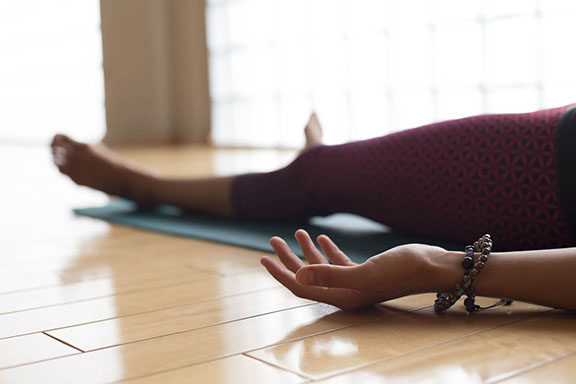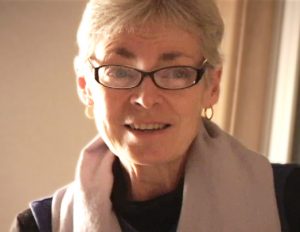 We don’t know when life will change, when we will be asked by life’s circumstances to let go. The Corpse pose, Savasana, gives some good clues about how to handle change: relax, don’t struggle, be in the moment, surrender, let go. This is renunciation. The pose shows us how to practice so we are prepared to release and let ourselves be transformed. Needless to say, it is not always easy to change. We may not feel very receptive to these new conditions or particularly desirous of the transformation, but I’ve learned that life will encourage surrender and renunciation one way or another.
We don’t know when life will change, when we will be asked by life’s circumstances to let go. The Corpse pose, Savasana, gives some good clues about how to handle change: relax, don’t struggle, be in the moment, surrender, let go. This is renunciation. The pose shows us how to practice so we are prepared to release and let ourselves be transformed. Needless to say, it is not always easy to change. We may not feel very receptive to these new conditions or particularly desirous of the transformation, but I’ve learned that life will encourage surrender and renunciation one way or another.
The work of letting go begins with relaxation—a big theme in Yoga. Worry, caused by an overactive imagination, can block the flow of energy and enthusiasm. As the body and mind relax and tension subsides, our perspective can shift to the positive, to the possible. This rejuvenating energy opens up the mind and the heart.
It’s been two years now since I was diagnosed with Parkinson’s disease. Accepting the facts of the disease has definitely been a process of letting go—of how I think my life should be and how I want it to be. Entering this process “yogically” involves staying cool in my imagination—not letting it get a head of steam. When it does, I’m launched into the future of “what ifs” and there is little relaxation in this state. So to maintain a balanced perspective I keep a daily record of moods, energy, motivation, attitudes, symptoms and practices. Being clear about the facts of my daily life helps me to relax.
By being initiated into Sannyas, I’ve made a commitment to practice renunciation and I’ve learned a lot about surrender. Surrender comes in small ways and big ways, and in not always doing it my way. My experience is that there is always something new to learn, to expand into, that makes the initial letting go more than worth it. The freedom that comes with relaxing my resistance to change is a real joy.
What needs to be renounced in matters of health? Attitudes, mostly, I think. The tension that gets built up—over the “what ifs” or self-consciousness or frustration—takes precious energy. Relaxing into the moment gives quite a lift. Humor may even be possible! One of the last things my Guru said to her students was, “Don’t take yourself or the world too seriously.” I let this thought echo in my mind over and over. It feels to me that attitude is everything.
There is a student coming to the Yoga class I teach who is fitted with a pump circulating the blood to his heart. A tube is connected from the pump inside him to the battery he wears on his hip. The pump makes swishing sounds all through class, reminding us of our mortality. He is wired for life—a precarious situation. He is waiting for heart and kidney transplants. He’s in the present. The phone could ring any moment—the doctor saying, “Come now.” He has to be ready. But of course he has no way of knowing when the call will come. So he practices. He practices the asanas to make himself strong and he practices his attitudes. He is very kind with everyone in the class, very positive, light. His sense of humor is always close to the surface. Life has asked him to surrender and he’s doing so gracefully. Everyone learns from him.
A year ago, he was fine. Then some upper back pain. It led to a massive heart attack. For months, he could barely move. Now he’s stretching, breathing, relaxing and finding the courage to face his situation.
Renunciation helps me now in dealing with Parkinsons. It brings me back over and over again to the idea of functioning from my center—not giving in to the pulls of self-will, tension or struggle. Some days the tension is there because my body is dancing to a rhythm that is still unfamiliar and unwanted. This is the most important time to relax, to soften and to hand over my feelings to the Divine. Let something else come into the picture. This is often a good time to lie down and do Savasana, tending to my body while cultivating acceptance and compassion.
Savasana is a chance to practice getting in touch with the purpose of life, the real reason for being here. What did I come to do? In the state of relaxation, new thoughts arise. The heart is nourished. There are many possibilities, many options. There is hope.
About the Author:
 The late Swami Radhakrishnananda was a disciple of Swami Sivananda Radha, who taught at Radha Yoga Center in Spokane, Washington. One of her focuses was understanding the body as a spiritual tool through the practice of Hatha Yoga and East Indian prayer dance. She left the body in 2012.
The late Swami Radhakrishnananda was a disciple of Swami Sivananda Radha, who taught at Radha Yoga Center in Spokane, Washington. One of her focuses was understanding the body as a spiritual tool through the practice of Hatha Yoga and East Indian prayer dance. She left the body in 2012.
Source: Originally published, in Ascent magazine, issue 20, Winter 2003, www.ascentmagazine.com. We thank Ascent for kind permission to reprint.

